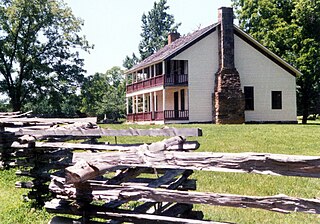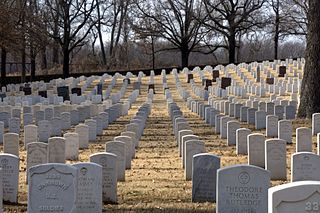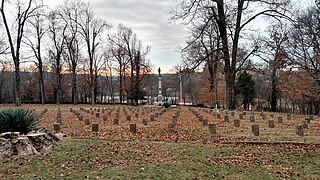
Washington County is a regional economic, educational, and cultural hub in the Northwest Arkansas region. Created as Arkansas's 17th county on November 30, 1848, Washington County has 13 incorporated municipalities, including Fayetteville, the county seat, and Springdale. The county is also the site of small towns, bedroom communities, and unincorporated places. The county is named for George Washington, the first President of the United States.

Prairie Grove is a city in Washington County, Arkansas, United States. The population was 7,045 at the 2020 Census. It is part of the Northwest Arkansas region, and home to Prairie Grove Battlefield State Park.

The Battle of Prairie Grove was a battle of the American Civil War fought on December 7, 1862. While tactically indecisive, the battle secured the Union control of northwestern Arkansas.

Pea Ridge National Military Park is a United States National Military Park located in northwest Arkansas near the Missouri border. The park protects the site of the Battle of Pea Ridge, fought March 7 and 8, 1862. The battle was a victory for the Union and helped it gain control of the crucial border state of Missouri.

Poison Springs Battleground State Park is an Arkansas state park located southeast of Bluff City. It commemorates the Battle of Poison Spring in the American Civil War, which was part of the 1864 Camden Expedition, an element of a Union Army initiative to gain control of Shreveport, Louisiana and get a foothold in Texas.

The battle of Cane Hill was fought between Union and Confederate forces during the American Civil War on November 28, 1862, in northwestern Arkansas, near the town of Cane Hill. Confederate Major General Thomas C. Hindman had made an abortive offensive into southwestern Missouri from Arkansas earlier in the year, but had withdrawn to Arkansas. Union troops under Brigadier General James G. Blunt had followed Hindman into northwestern Arkansas, and the Confederate general saw an opportunity to attack Blunt while his division was separated from the rest of the Union Army of the Frontier. Hindman then sent a force under Brigadier General John S. Marmaduke to Cane Hill, which was also known as Boonsboro, to collect supplies. In early November, a detachment of Blunt's command led by Colonel William F. Cloud defeated a small Confederate force commanded by Colonel Emmett MacDonald in the Cane Hill area.

Olustee Battlefield Historic State Park is a Florida State Park in the Osceola National Forest, near the town of Olustee. The site of Florida's largest Civil War battle, the Battle of Olustee. The park is located 50 miles (80 km) west of Jacksonville and 15 miles (24 km) east of Lake City, on U.S. 90. It was one of the first parks in the Florida State Park system.

Fayetteville National Cemetery is a United States National Cemetery located on the southern side of the city of Fayetteville in Washington County, Arkansas. It encompasses nearly 15 acres (6.1 ha). As of 2020, over 11,000 veterans and family members were interred in this location, with approximately 200 new burials per year.

Fort Smith National Cemetery is a United States National Cemetery located at Garland Avenue and Sixth Street in Fort Smith, Sebastian County, Arkansas. It encompasses 22.3 acres (9.0 ha), and as of the end of 2005, had 13,127 interments.

Elkhorn Tavern is a two-story, wood-frame structure that served as a physical center for the American Civil War Battle of Pea Ridge, also known as the Battle of Elkhorn Tavern, which was fought on March 7 and March 8, 1862, approximately five miles east of Pea Ridge, Arkansas, located in the northeastern Benton County, Arkansas. The tavern, a replica built in 1865 following the burning of the original building by bushwhackers, is now the centerpiece of the Pea Ridge National Military Park, which includes approximately 5,000 acres (2,000 ha) around the structure, including the restored battlefields, a stretch of the pre-war Telegraph Road, which runs directly in front of the tavern, and a section of the Trail of Tears. The tavern is on the National Register of Historic Places.

During the American Civil War, Arkansas was a Confederate state, though it had initially voted to remain in the Union. Following the capture of Fort Sumter in April 1861, Abraham Lincoln called for troops from every Union state to put down the rebellion, and Arkansas along several other southern states seceded. For the rest of the civil war, Arkansas played a major role in controlling the Mississippi River, a major waterway.
The Jenkins' Ferry Battleground State Park, also known as the Jenkins' Ferry Battlefield, is a battlefield in Grant County, Arkansas. The Arkansas state park commemorates the Battle of Jenkins' Ferry fought on Saturday, April 30, 1864, during the Red River Campaign of the American Civil War.

The Prairie D'Ane Battlefield, also known as Prairie D'Ann Battlefield or Prairie De Ann Battlefield in anglicized forms, was the site of the Civil War Battle of Prairie D'Ane, one of the engagements in southwestern Arkansas of the Union's Camden Expedition of 1864. It was listed on the National Register of Historic Places in 1974, and, with other sites, is part of the Camden Expedition Sites National Historic Landmark. It was declared part of the National Historic Landmark in 1994.

The Confederate State Capitol building in Washington, Arkansas was the capital of the Confederate state government of Arkansas, during 1863–1865, after Little Rock, Arkansas fell to Union forces in the American Civil War. It is located within Historic Washington State Park, and is a National Historic Landmark.

The Borden House is a historic house on the grounds of Prairie Grove Battlefield State Park in Prairie Grove, Arkansas. In the Battle of Prairie Grove on December 7, 1862, the original Borden House was one of the central points of the Confederate line, and was the scene of heavy casualties. The Borden House was burned the next day. Archibald Borden built the current house on the original site. It is a 1+1⁄2-story wood-frame house, five bays wide, with a side-gable roof pierced by three gabled dormers. A porch extends across the center three bays of the front.

The 22nd Arkansas Infantry Regiment was a Confederate Army infantry regiment during the American Civil War (1862–1865). This regiment was originally organized as the 17th Arkansas Infantry Regiment, reorganized after the battle of Pea Ridge as 1st Regiment, Northwest Division, Trans-Mississippi Department, or Rector's War Regiment, redesignated as the 35th Arkansas in the summer of 1862, and reorganized and redesignated as the 22nd Arkansas following the Battle of Prairie Grove. The unit was also sometimes referred to as, King's Arkansas Infantry or McCord's Arkansas Infantry. This was the second regiment to be officially designated as the 22nd Arkansas. The first was mustered in at DeValls Bluff, Arkansas, on April 9, 1862, and later reorganized as the 20th Arkansas Infantry Regiment.

Fayetteville Confederate Cemetery is a cemetery for soldiers of the Confederate States located on the eastern side of Fayetteville in Washington County, Arkansas. Added to the National Register of Historic Places (NRHP) in 1993, the cemetery encompasses 3.5 acres (1.4 ha).
The Civil War Trust's Civil War Discovery Trail is a heritage tourism program that links more than 600 U.S. Civil War sites in more than 30 states. The program is one of the White House Millennium Council's sixteen flagship National Millennium Trails. Sites on the trail include battlefields, museums, historic sites, forts and cemeteries.

The Prairie Grove Airlight Outdoor Telephone Booth is a telephone booth installed at the southwest corner of East Douglas and Parker Streets in Prairie Grove, Arkansas, United States. It is an early example of the Airlight, the first American mass-produced weather-resistant metal telephone booth, which made possible widespread installation of outdoor payphones. In 2015, it became the first phone booth on the National Register of Historic Places.
The Mansfield State Historic Site, also known as the Mansfield Battlefield, is a battlefield in DeSoto Parish, Louisiana. The Louisiana state historic site commemorates the Battle of Mansfield fought on Friday, April 8, 1864, during the Red River Campaign of the American Civil War. The site was listed in the U.S. National Register of Historic Places as the Mansfield Battle Park in 1973. Established in 1924 by the United Daughters of the Confederacy, the site was transferred to the state of Louisiana in 1954.


















